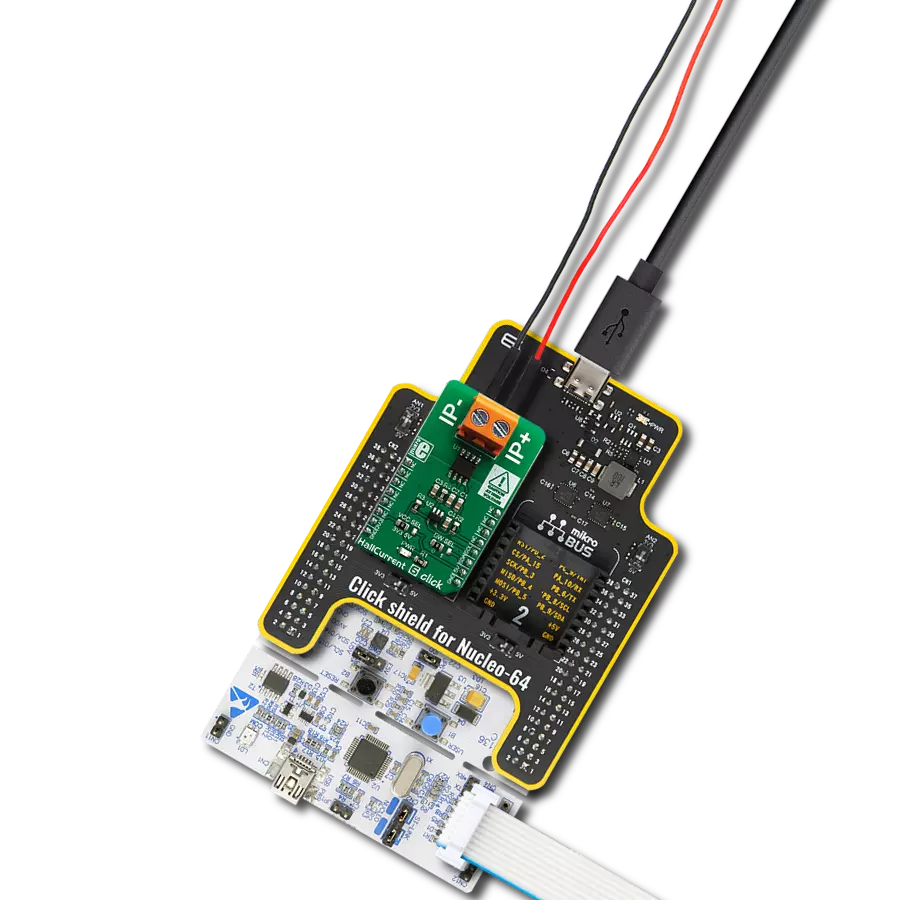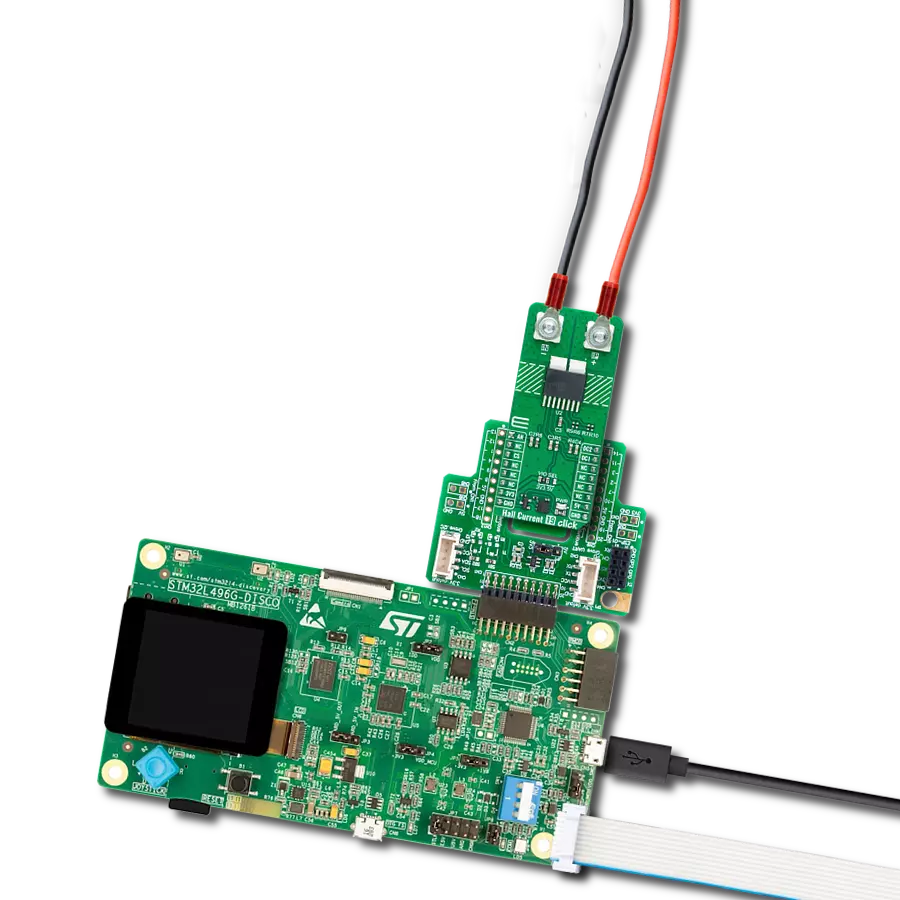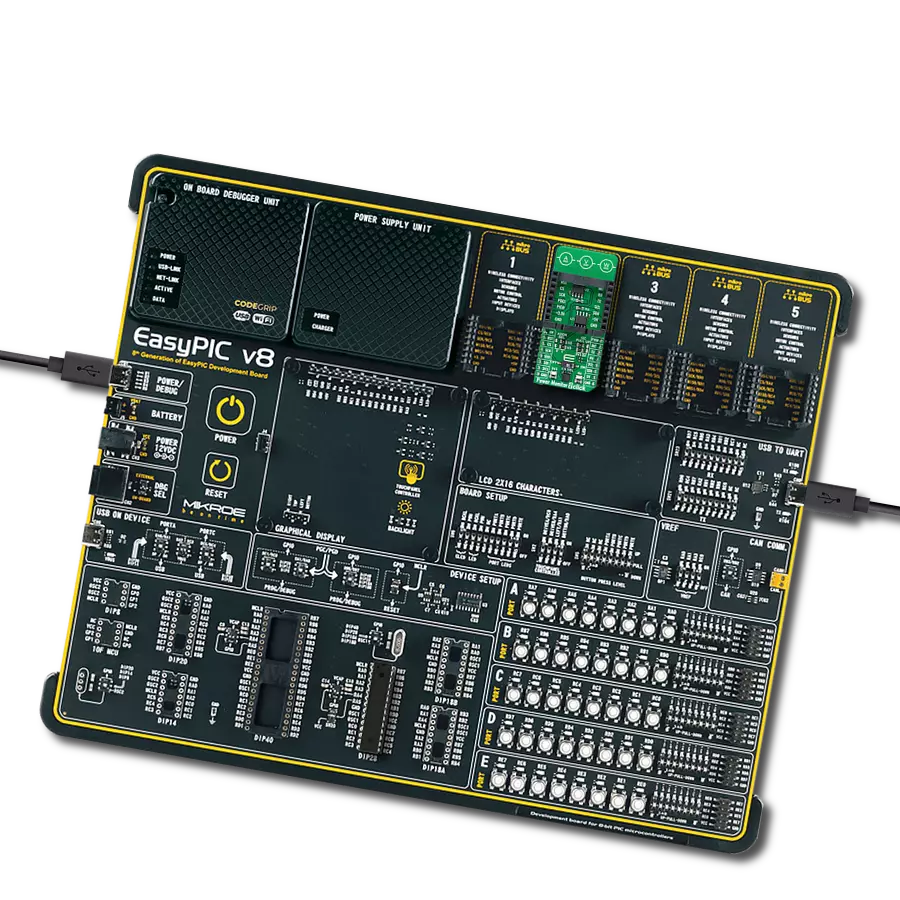Precise monitoring and control of both AC and DC currents, suitable for a wide range of applications where accurate current measurement and safety are crucial
A
A
Hardware Overview
How does it work?
Current Sens 2 Click is based on the HO 10-P, an AC/DC current transducer from LEM USA. The HO 10-P is well-known for measuring DC, AC, and pulse currents up to 10ARMS with galvanic isolation between the primary and secondary circuits. With its core built on the open-loop Hall effect measuring principle, the Current Sens 2 Click ensures precise and reliable current measurements. Its capability covers a variety of industrial applications, including AC variable speed drives, UPS systems, SMPS, and power supplies for welding, which benefit from low power consumption and high immunity to external interference. The device's fast response time suits dynamic and demanding environments. The HO 10-P is designed for through-hole PCB mounting and features a sizable aperture (8x8mm) for the primary
conductor, ensuring easy integration and versatility. Although the sensor can measure current up to 10A, its sensitivity can be altered in three specific scenarios. When current is applied to the input, for instance, pin 6, and the output is obtained from pin 11, the sensor's sensitivity becomes x1. This configuration is considered as the wire being wound only once around the sensor's core, marking the first scenario. In another configuration, short-circuiting pins 7 and 10 while keeping the input and output on pins 6 and 11 doubles the sensitivity (x2). Similarly, sensitivity triples (x3) when pins 7-10 and 8-9 are short-circuited, maintaining the input and output on pins 6 and 11. Maintaining a straight signal path from the input to the output is crucial, as depicted in the schematic (6-11, 7-10, 8-9). It's also possible to measure the conductor's current by
pulling it through the sensor's core and allowing current to flow through it. The sensor is powered by the 5V mikroBUS™ power rail and outputs the sensed current as an analog signal through the AN pin. Additionally, an orange LED and a dedicated pin (OCD) on the mikroBUS™ socket signal an overcurrent condition, providing enhanced safety and monitoring features. This Click board™ can operate with either 3.3V or 5V logic voltage levels selected via the VCC SEL jumper. This way, both 3.3V and 5V capable MCUs can use the communication lines properly. Also, this Click board™ comes equipped with a library containing easy-to-use functions and an example code that can be used as a reference for further development.

Features overview
Development board
Curiosity PIC32 MZ EF development board is a fully integrated 32-bit development platform featuring the high-performance PIC32MZ EF Series (PIC32MZ2048EFM) that has a 2MB Flash, 512KB RAM, integrated FPU, Crypto accelerator, and excellent connectivity options. It includes an integrated programmer and debugger, requiring no additional hardware. Users can expand
functionality through MIKROE mikroBUS™ Click™ adapter boards, add Ethernet connectivity with the Microchip PHY daughter board, add WiFi connectivity capability using the Microchip expansions boards, and add audio input and output capability with Microchip audio daughter boards. These boards are fully integrated into PIC32’s powerful software framework, MPLAB Harmony,
which provides a flexible and modular interface to application development a rich set of inter-operable software stacks (TCP-IP, USB), and easy-to-use features. The Curiosity PIC32 MZ EF development board offers expansion capabilities making it an excellent choice for a rapid prototyping board in Connectivity, IOT, and general-purpose applications.
Microcontroller Overview
MCU Card / MCU

Architecture
PIC32
MCU Memory (KB)
2048
Silicon Vendor
Microchip
Pin count
100
RAM (Bytes)
524288
Used MCU Pins
mikroBUS™ mapper
Take a closer look
Click board™ Schematic

Step by step
Project assembly
Track your results in real time
Application Output
1. Application Output - In Debug mode, the 'Application Output' window enables real-time data monitoring, offering direct insight into execution results. Ensure proper data display by configuring the environment correctly using the provided tutorial.

2. UART Terminal - Use the UART Terminal to monitor data transmission via a USB to UART converter, allowing direct communication between the Click board™ and your development system. Configure the baud rate and other serial settings according to your project's requirements to ensure proper functionality. For step-by-step setup instructions, refer to the provided tutorial.

3. Plot Output - The Plot feature offers a powerful way to visualize real-time sensor data, enabling trend analysis, debugging, and comparison of multiple data points. To set it up correctly, follow the provided tutorial, which includes a step-by-step example of using the Plot feature to display Click board™ readings. To use the Plot feature in your code, use the function: plot(*insert_graph_name*, variable_name);. This is a general format, and it is up to the user to replace 'insert_graph_name' with the actual graph name and 'variable_name' with the parameter to be displayed.

Software Support
Library Description
This library contains API for Current Sens 2 Click driver.
Key functions:
currentsens2_get_int_pin- Current Sens 2 get int pin state functioncurrentsens2_tare- Current Sens 2 tare functioncurrentsens2_get_current- Current Sens 2 read current function
Open Source
Code example
The complete application code and a ready-to-use project are available through the NECTO Studio Package Manager for direct installation in the NECTO Studio. The application code can also be found on the MIKROE GitHub account.
/*!
* @file main.c
* @brief Current Sens 2 Click Example.
*
* # Description
* This example demonstrates the use of Current Sens 2 Click board by reading and
* displaying the input current measurements.
*
* The demo application is composed of two sections :
*
* ## Application Init
* Initializes the driver and logger.
*
* ## Application Task
* Reads the input current measurements and displays the results on the USB UART
* approximately once per second.
*
* @author Stefan Ilic
*
*/
#include "board.h"
#include "log.h"
#include "currentsens2.h"
static currentsens2_t currentsens2; /**< Current Sens 2 Click driver object. */
static log_t logger; /**< Logger object. */
void application_init ( void )
{
log_cfg_t log_cfg; /**< Logger config object. */
currentsens2_cfg_t currentsens2_cfg; /**< Click config object. */
/**
* Logger initialization.
* Default baud rate: 115200
* Default log level: LOG_LEVEL_DEBUG
* @note If USB_UART_RX and USB_UART_TX
* are defined as HAL_PIN_NC, you will
* need to define them manually for log to work.
* See @b LOG_MAP_USB_UART macro definition for detailed explanation.
*/
LOG_MAP_USB_UART( log_cfg );
log_init( &logger, &log_cfg );
log_info( &logger, " Application Init " );
// Click initialization.
currentsens2_cfg_setup( ¤tsens2_cfg );
CURRENTSENS2_MAP_MIKROBUS( currentsens2_cfg, MIKROBUS_1 );
if ( ADC_ERROR == currentsens2_init( ¤tsens2, ¤tsens2_cfg ) )
{
log_error( &logger, " Communication init." );
for ( ; ; );
}
log_printf( &logger, " Remove Click from the electrical circuit \r\n" );
Delay_ms ( 1000 );
if ( CURRENTSENS2_ERROR == currentsens2_tare ( ¤tsens2 ) )
{
log_error( &logger, " Click tare error." );
for ( ; ; );
}
currentsens2_set_prim_turn_no( ¤tsens2, CURRENTSENS2_NUM_OF_PASSES_1 );
log_printf( &logger, " Connect Click to the electrical circuit \r\n" );
log_info( &logger, " Application Task " );
}
void application_task ( void )
{
float current = 0;
if ( CURRENTSENS2_OK == currentsens2_get_current ( ¤tsens2, ¤t ) )
{
log_printf( &logger, " Current : %.2f[A]\r\n\n", current );
Delay_ms ( 1000 );
}
}
int main ( void )
{
/* Do not remove this line or clock might not be set correctly. */
#ifdef PREINIT_SUPPORTED
preinit();
#endif
application_init( );
for ( ; ; )
{
application_task( );
}
return 0;
}
// ------------------------------------------------------------------------ END

































